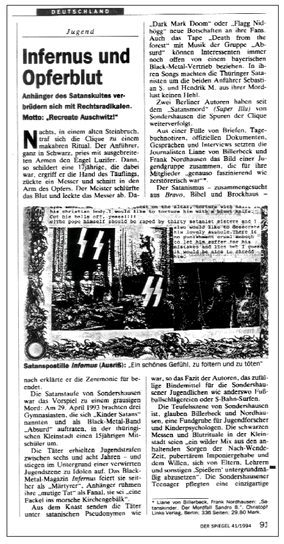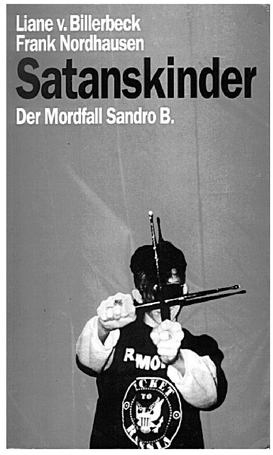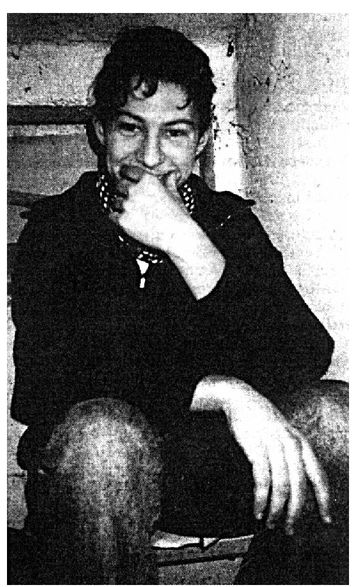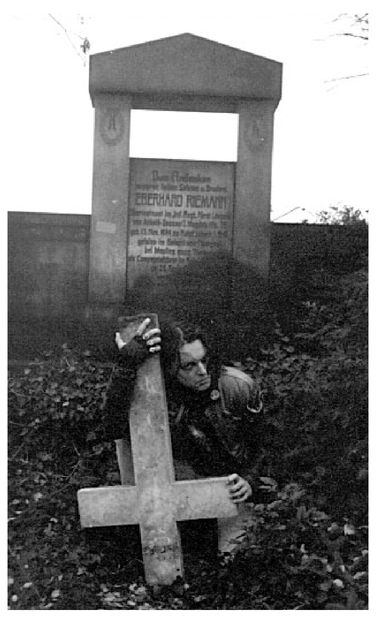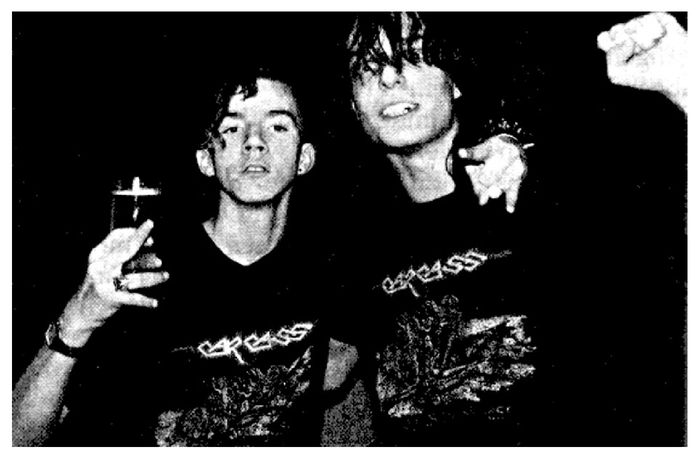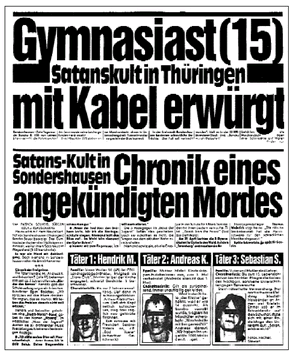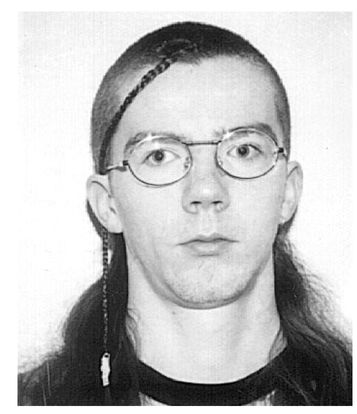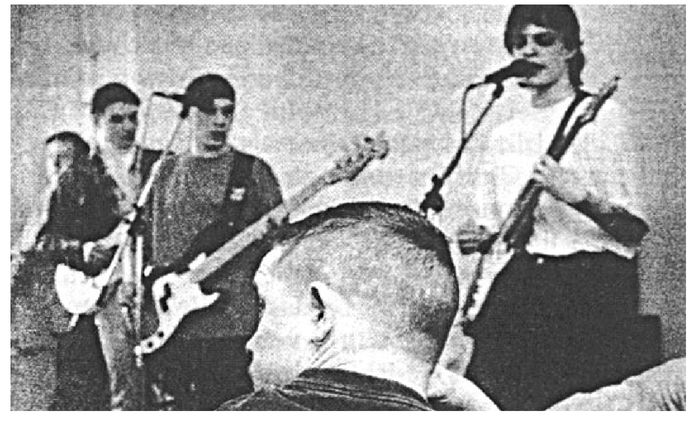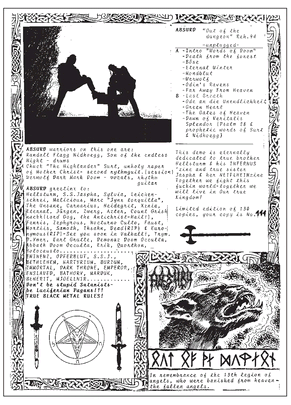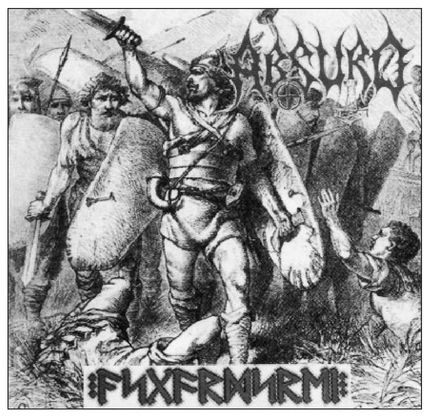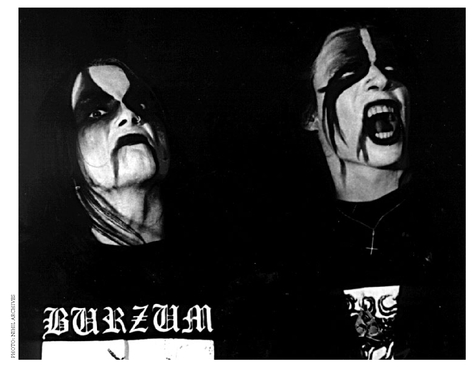GERMANY DESERVES SPECIAL TREATMENT... I LOVE GERMANY AND THE GERMAN FOLK... THERE IS NO PEOPLE IN THE WORLD WHO HAVE BEEN TREATED MORE UNJUST THAN THE GERMAN FOLK; THE LEAST I CAN DO IS TO SHOW ... BURZUM FAVORS DEUTSCHLAND TO THE REST OF THE WORLD. RISE DEUTSCHLAND, TAKE BACK YOUR GLORY. WOTAN IS WITH US.
11
FUROR TEUTONICUS
IN THE FALL OF 1994, THE UBIQUITOUS GERMAN WEEKLY DER SPIEGEL, THAT country’s left-leaning equivalent of
Time magazine, published an article in its national pages under the “Youth” subsection
. “Infernus and Sacrificial Blood,”
2 the headline screamed. In the center of the page the reader encounters an illustration from the fanzine
Infernus—an image of corpses in battle gear juxtaposed with a xeroxed picture of an SS ceremony from the Third Reich. A statement adjacent to the pictures is also legible:
The pope himself should be raped by thirty Satanist sisters and I also would like to desecrate his lovely asshole. There is no punishment cruel enough to let him suffer for his mistakes and lies but I guess it would be nice to shred him.
3
Welcome to the world of German Black Metal. Less well known than its Norwegian counterpart, the German scene remains genuinely underground, an obscure exit off the darkened Autobahn of extreme Rock. That changed briefly following the night of April 29, 1993, however, when the members of the Black Metal band Absurd followed the example set by Bård Eithun and Varg Vikernes and replaced thought with crime. The exploits of Absurd lacked the grand drama and notoriety which surrounded the “Grishnackh-Euronymous affair” later that year, but the violence was just as intense. They demonstrated that while fewer in number, the Teutonic wing of Black Metal was willing to live up to its Nordic cousin in terms of making a point without fear of the consequences—be they derision or prison time.
DER SPIEGEL ARTICLE
The article in the normally staid Der Spiegel begins in a manner more befitting a pulp tabloid:
By night the clique meets for macabre rituals in an old quarry. The leader, dressed in black, praises the angel Lucifer with outstretched arms. Then, according to a 17-year-old who was present, he grips the hand of the one to be baptized, draws a knife, and makes a cut in the arm of the initiate. The Master slurps the blood and licks the knife. He then declares the ceremony has ended.
4
The article continues, explaining that the Satanic baptism which took place in Sondershausen was only a prelude to a more gruesome event to come in April, 1993. On that day, members of the group of high school students who allegedly called themselves the “Children of Satan” engineered the murder of a 15-year-old class-mate. The murderers were later found to all be members of a macabre fledgling music group named Absurd.
The Spiegel piece was one of dozens in a media frenzy that brought national attention to the nondescript town of Sondershausen, located in the state of Thuringia in former East Germany. The research of two journalists from Berlin, Lianne von Billerbeck and Frank Nordhausen, culminated in the book Satanskinder (“Satan’s Children”), published in 1994. The subtitle of the book is “The Murder Case of Sandro B.,” which refers to the name of the victim, Sandro Beyer. Written in a straightforward manner, Satanskinder attempts to unravel what really happened within the youth milieu surrounding Absurd, and what influences may have contributed to the murderers’ behavior.
According to the authors’ findings, a small subculture had emerged amongst a few young high school students who shared a growing fascination with extreme Heavy Metal, the occult, violence, and horror films. Such curiosities were difficult to satisfy until the Wall fell in 1989 and East Germany was opened to the West. At this point previously forbidden or impossible-to-obtain records and videos steadily came within reach. The three 17-year-olds Hendrik Möbus, Sebastian Schauscheill, and Andreas Kirchner began to draw attention to themselves with their Satanic obsessions and penchant for Black Metal. They were antagonized for their interests by many of the other kids in town—both left-wing punks and right-wing skinheads—but developed a group of admirers among the local schoolgirls.
As their imaginations were increasingly stimulated, they began to meet with a small circle of adherents in the rock quarry where they supposedly held Satanic “baptism” ceremonies like the one so dramatically described in Der Spiegel. At a certain point in 1992, a younger student, a 14-year-old named Sandro, also developed a fascination for the members of this sinister band and their associates.
The descriptions of Sandro Beyer in Satanskinder make it is hard to sympathize with his personality. Widely disliked due to his irritating manners, he had almost no real friends. He quickly began to adopt the style and interests of the “Satanists” and desperately tried to ingratiate himself into their circle. He would ask to attend band rehearsals and began corresponding with them and the others in the clique around Absurd. Satanskinder describes a peculiar “letter writing culture” that thrived among all of these youths. Opinions, concerns, and demands were sent back and forth among the penpals, even though they lived within walking distance of one another and met frequently at locations such at the Youth Center, where Absurd rehearsed for a time. Heated arguments also took place there between them and members of the Christian Youth Club, which met regularly at the Center as well.
SATANSKINDER BOOK COVER
ABSURD LOGO
Sandro’s parents, both Christians, frowned upon his new clique and refused to tolerate the accouterments that had come with it. On one occasion they burned one of his T-shirts, which bore a pentagram, after his father exclaimed it was a “symbol of the Devil.”
5 Only a short time passed before Sandro himself realized such things were not his cup of tea, anyway. The boys of Absurd had never accepted Sandro into their fold, and visibly displayed their dislike towards him. In response to their constant insults, he began to argue and taunt them in return—further provoking their wrath. At one point he promised his mother, “Mommy, don’t worry, I won’t hang around with these people, they’re too brutal to me,” and threw away all the Satanic items in his room.
6SANDRO BEYER
Despite his claims that he had broken all ties with the Absurd crowd, he still felt drawn to them. His attraction was now soured but consuming, like that of a spurned secret admirer. Together with a young girl named Rita, Sandro began to plot actions against Sebastian and Hendrik, hoping to make a mockery of them in Sondershausen. He began a campaign of writing slander letters and spreading unpleasant rumors. He was also aware of an ongoing affair between Sebastian and an older married woman named Heidegrit Goldhardt, now pregnant with Sebastian’s child. Sandro threatened to reveal the clandestine adultery to the rest of the town. Upon receiving word of this, Sebastian replied to Sandro in writing, issuing the threat: “Primitive violence is not our thing. Sorcery is more effective.”
7 He sent a further message, partially in English: “The hell come to your home. You will die. Sathan awaits! Stay away from us you whimp and poser! Sathan be my guard [sic].”
8All the while—if the statements in Satanskinder are to be believed—emotions were tense among Hendrik, Sebastian, and their close friends. Intrigues and jealousies arose over new allegiances and preoccupations. Sebastian’s romantic relationship with Heidegrit, who oddly enough was an evangelical Christian schoolteacher, had produced some unexpected results. He had joined in with her pet projects for environmentalism and animal rights, and now spent time writing polemical letters to the newspapers about such issues. He developed a double life between these activities and nights spent with Absurd, rehearsing their Luciferian hymns and drinking. The parties occasionally led to wild outbreaks; one night they invaded a deserted house and destroyed much of the contents in a drunken fury.
SEBASTIAN SCHAUSCHEILL
The biggest problem for the group—one that they all agreed needed to be dealt with—was Sandro. Sebastian later told the police, “It was only just that lately Sandro had gotten on our nerves with his appearance. He had such a tactless manner … and because we were slightly fixated upon him, this caused an idea to form.”
9In a bizarre interview done with a high school fanzine in late 1992, Hendrik broadcast an array of vehement unpleasantries and exaggerated claims, much in the same spirit as some of Varg Vikernes’s grandiose early statements to the Norwegian press. When asked who Absurd considered their allies, he took pains to specify by name that “Sandro B.” had nothing to do with them—he was the type of person they abhorred. Undoubtedly the publication of this interview slammed another thorn in the side of the disgruntled Sandro, increasing his resolve to embarrass Hendrik and Sebastian.
Absurd no longer rehearsed at the Youth Center, but had moved their equipment to a small cottage built by Hendrik’s father in the nearby woods. Through the guise of a female friend, “Juliane,” a letter was sent to Sandro in which she confided her hatred of Absurd. She asked Sandro to meet her one evening at the Rondell, a WWI memorial in the forest above the town, in order to discuss how she could contribute to Sandro’s campaign against the Satanists.
HENDRIK AND SEBASTIAN
Sandro arrived at the Rondell as scheduled. It was 8 P.M. on the evening of April 29th, the night before the heathen and Satanic holiday of Walpurgisnacht. “Juliane” didn’t appear, but the members of Absurd did instead. Sandro must have been confused, but dismissed any idea that he had been set up. They then somehow convinced him to accompany them elsewhere so that they could all discuss an important matter.
They led him through the woods to the bungalow belonging to Hendrik’s father. At approximately 8:30 the group of youths entered the cottage. Once inside they invited Sandro to take a seat, giving the impression that they now would undertake their discussion. Sandro was unsure what was going on, and stated, “It’s getting to be too much for me.”
10 He was ready to leave. Suddenly Andreas grabbed an electrical cord and wrapped it around Sandro’s neck. A struggle ensued, Sandro tried to scream for help. At this point, Hendrik is alleged to have pulled a knife and cut Sandro. They tied his hands behind his back. Sandro begged to be let free, promising to never speak about anything that had just happened. They could even have his life savings—500 German Marks (approximately $325). The boys considered the idea of letting him go free in the woods, but feared he would not keep his promise of silence about the abduction, especially now that he had been wounded.
Sandro began screaming for help again and struggling to break free. The boys leapt upon him, Hendrik grabbing his legs. Andreas and Sebastian threw a piece of the electrical cord around his neck and tightened it from both sides with all their might. They held it in determined tautness until certain that Sandro’s heart had come to a standstill.
When the reality of the preceding frenzied few minutes sunk in, Andreas is alleged to have remarked, “Oh shit—now I’ve completely ruined my life.”
11 The other two convinced him there might be a way they could get away with the crime; they simply needed to dispose of the body. The three hauled the corpse about a hundred yards away from the cottage, where they hid it in a dilapidated shed by a creek. They went home for the night.
It was only a matter of hours before Sandro’s parents and the police were looking into the disappearance. On May 1st the three members of Absurd returned to the scene of the crime and dragged Sandro’s corpse, wrapped in a blanket, to a nearby excavation pit, where they quickly buried him.
The corpse was found almost immediately, and the trail of the strangled 15-year-old quickly led to Sebastian, Hendrik, and Andreas. Once caught, they were tried for murder and convicted. The case elicited a steady stream of excited headlines from journalists determined to present it as some kind of “Satanic sacrifice.” During the initial police interviews and on the stand in the court hearings, Sebastian only provided ambiguous justifications for the killing, none of which had anything to do with Satanism. “It could not have happened any other way. It was simply inside of us, like a compulsion,” he explained. He admitted that the idea of killing Sandro had been come up a week before the deed, but maintained the murder had been “relatively spontaneous,” and there was “no logical motive.” In Sebastian’s words, “the guy simply had to go.”
12Asked whether the violent imagery of Black Metal music had provided a motivation for their behavior, Sebastian conceded it may have been a slight influence, but he was reluctant to blame Heavy Metal. Despite the brutal lyrics, the music was not a main factor in what they had done. Sebastian related a strange personal anecdote: about six months before the murder he heard a voice in his head. It was difficult to understand; he thought it uttered the nonsensical phrase
“Küster Maier.” Later he decided it probably must have said
“töte Beyer” (“Kill Beyer!”). He added, “It sounds crazy, I know, but I can’t really say what I have experienced.”
13SEBASTIAN AND HENDRIK
THE LAST PHOTO EVER TAKEN OF SANDRO BEYER
Hendrik and Sebastian were clearly the real forces behind the ideology and imagery of Absurd. Andreas appears to have been mainly an impressionable follower. All of them have refused interviews for years and would not speak to the press about the action they took. The story detailed above follows the chronology presented in Satanskinder, although the book embellishes it with endless psychological speculation. The descriptions of the authors are based entirely on comments by disgruntled ex-friends and hangers-on who had interacted with the killers, since the latter refused to speak to them. The picture painted is one of an outsider group of youths whose fantasies got the best of them. Increasingly driven by melodrama, they finally crossed over the line to where the horror and violence turned real.
How much of a resemblance the Satanskinder account bears to reality is hard to say. If one speaks to the killers directly, it becomes apparent that there was clearly more going on in their minds than the book would have you believe. The following interview is derived from correspondence that took place during 1997–2002 between Hendrik Möbus and the authors of this book. It was the first time he had agreed to speak about the murder of Sandro Beyer since the killing took place. The reader should keep in mind that his answers come with the hindsight of a number of years which have passed since Sandro Beyer fulfilled his date with “death from the forest.” Hendrik’s replies also illustrate well the extent that strains of esoteric racialist mysticism have permeated some aspects of Black Metal. For the present edition of Lords of Chaos, some answers in the earlier interview have been revised or expanded upon, and Hendrik also discusses events that took place after his release from juvenile incarceration. In a number of instances he appears to have tempered some of his earlier rhetoric. Those wishing to read his previous responses may consult the first edition of this book.
HENDRIK MÖBUS
WHAT WERE THE PRIMARY INFLUENCES WHEN YOU WERE YOUNGER?
I guess we always felt linked to some kind of “counter-reality,” to the things that were “absurd” to society. Certainly this link must be seen in reference to our life in the Soviet Occupation Zone of East Germany, where we grew up for our first fourteen years. The East German government was a totalitarian one—the dictatorship of the workers and peasants. People raised in the “Free World” will never wholly understand these kinds of social structures. Besides, it was never anything but a satellite of “Big Brother” Moscow, totally oriented toward and dependent on the U.S.S.R. Thus we were taught to love everything Russian, but to hate our own nationality. But nobody can deny his origin, and this contradiction-in-terms displeased us, making us look for something beyond the Communists’ agitprop.
INFERNUS FANZINE, WITH ABSURD ON COVER
WHAT SUBJECTS WERE YOU INTERESTED IN?
At home, I learned quite a bit about ancestral research, German history, about folklore and fairytales, and of the love for untouched nature. As a kid back then there was much less of a possibility for wasting away one’s day in front of the TV, and so a lot of time was enjoyably spent outside. At church—keep in mind, though, that the East German society was almost wholly atheistic—I learned to deal with religious topics, but unfortunately I also learned all the Semitic fairytales from the Old Testament. But at least through this I got an insight into the Christian mindset. However, Sebastian and my big brother and I all felt the same way, and like certain others our age, we tried to escape the dull and indoctrinated society by affiliating with some kind of youth culture.
HOW DID YOU FIRST BECOME INTERESTED IN EXTREME MUSIC, AND LATER BLACK METAL?
To listen to any other music than the “politically correct” was of course frowned upon, and thus, it became a special form of protest. We used to listen to British and German Punk Rock, British Oi, as well as Thrash Metal. It was rather hard to get any releases; mostly we obtained Polish or Hungarian bootlegs, or recorded stuff from the West German radio. We developed more and more of a preference for the “sinister” Metal stuff (both in terms of music and attitude)—for example Slayer, Destruction, Sodom, Morbid Angel, Possessed. We felt this music best fit our attitude and point of view.
DID YOU HAVE A DIFFERENT PERSPECTIVE, OR DIFFERENT ACCESS TO THESE THINGS SINCE YOU LIVED IN WHAT WAS A PART OF EASTERN GERMANY?
In late ’89 the East German government fell apart, fading away like a flame without fuel. We had realized that this system couldn’t survive without Soviet support, even if the Communist Party tried to teach us that Communism would one day achieve worldwide victory. Now we have seen that a system that wants to equalize people by oppressing national feelings holds no great future.
All that we learned from the East German experience is that we must remain linked to our origins, as a condition for vital development. To sever the roots leads to disadvantage in every way, and that is true in individual circumstances as well. The Communists wanted to teach us Strength and Honor about being part of their “World Revolution,” but they revealed weakness and dishonor—we loathe them and their utopia. Nevertheless, from the ruins of East Germany we followed our trail for strength and honor, and I guess it was just a question of time before we became aware of splendid bands like Deicide, Beherit, Sarcofago, Bathory, Mayhem, and Darkthrone...
WHEN DID YOU FORM ABSURD, AND WHAT IS THE EARLY HISTORY OF THE BAND?
We didn’t choose the bandname on a whim, but rather because to our minds “absurd” was a very fitting description for the attitude held by the wider masses toward those things which we did at that time and which were dear to us. We were never actually understood. Our thought and behavior was seen as being in conjunction with manifestations that were wild, bewildering, destructive and subversive. This chaos, which we apparently represented for many people, was seized upon and manifested by us.
Though we started the band on January 2, 1992, we had played music together before, but more just for fun and without serious intentions. Up to this time, Sebastian already played guitar for many years, and I attended a local music school; thus we always listened to music as well as created it.
Nevertheless, after Darkthrone released their awe-inspiring A Blaze in the Northern Sky album in 1991, we felt the urge to express our very own “sinister attitude” in music as well, namely the reborn Black Metal. And even though we were quite impressed by Norwegian Black Metal, we didn’t want to copy their style of music.
WHAT ELSE INSPIRED YOU?
The Black Metal we play is influenced by Oi and R.A.C. [Rock Against Communism, a Nazi skinhead music organization] as well, and our inspiration came from various bands like Der Fluch, Mercyful Fate/King Diamond, Manowar, Danzig—this probably explains why our own music is so “un-Nordic” in sound. The classic movies of Bela Lugosi, Fritz Lang, Vincent Price (mostly the Hammer films), and Leni Riefenstahl influenced our ambience due to their own atmosphere and aesthetics (especially in regards to Riefenstahl). Almost the same goes for modern films by Dario Argento, Sam Raimi, and such. The biggest inspiration, though, came from the Conan the Barbarian film (and its soundtrack). Unjustly this film has been deemed a B-movie. The direction was done by John Milius, who among other things wrote the screenplay for Apocalypse Now. For Conan he wrote the screenplay as well, together with Oliver Stone. The result was a very multileveled and powerful film, the theme of which is probably obvious: the confrontation between the man of the North, adorned with a sunwheel, and the high priest of the Semitic snake cult. The movie is fantastic and, for us, possibly the best motion picture made since 1945. There have been many inspirations we tried to drop into our music, but the most important ones came from our inner self.
DID YOU PLAY CONCERTS?
Even when we had the chance to play live in our local Youth Center, we cancelled our participation, because we didn’t want to be onstage alongside the leftist morons of various Punk bands, or the faggots of a Blues band.
GERMAN HEADLINE: “HIGHSCHOOLER (15) STRANGLED
WITH CORD. SATAN CULT IN SONDERSHAUSEN.
CHRONICLE OF AN ANNOUNCED MURDER”
HENDRIK IN PRISON
WHERE DID MOST OF THE FANS OF ABSURD COME FROM?
Our strongest supporters come from Germany, mainly central Germany (the former East German territories), but from the western part as well. Besides this we have fans in many other Black-Metal-compatible countries around the globe. We praise everyone who really feels attracted to our music, and who supports us. It is also observable that many of the fans don’t originally come from the Black Metal scene at all. Among our fans we have skinheads and people into Industrial and Ambient music as well. And inevitably just as there are many fans, there are also some enemies. The latter mostly turn up in those circles where Black Metal is just one of the musical genres they listen to. They level the incensed, jealous accusation against us that Absurd just want to drag Black Metal into the dirt.
WERE THE NORWEGIAN BLACK METAL BANDS AN INFLUENCE ON YOU?
As far as the music is concerned, we received less influence from Norway, but considering their “way of life,” we still are rather fond of them. The Svarte Sirkel [Black Circle] exactly expressed an attitude similar to ours: fierceness, darkness, cruelty, somber mysteries, and extreme denial of the “Christianized modern world.” The behavior of the Svarte Sirkel bands/musicians towards the music biz impressed us quite a lot, and we were glad to see Black Metal boycotted by the major labels due to the “shocking and entangling” image the Norwegians had outlined for themselves. Reviewing these glory days of ’92 and early ’93, I doubt there will ever be such splendid feelings toward Black Metal again. Reminiscing about it brings on nostalgia.
SEBASTIAN (FAR RIGHT) IN PRISON BAND
DID YOU HAVE CONTACT WITH PEOPLE FROM NORWAY?
We have had and still have a strong relationship with the Norwegians. Before he “moved to the beyond,” Øystein Aarseth wanted to sign Absurd to Deathlike Silence, since our Death from the Forest demo appealed to him quite a bit.
WHICH GROUPS DID YOU FIND THE MOST IMPORTANT FROM THIS TIME?
Actually all of the Deathlike Silence bands, such as Mayhem, Burzum, Emperor, Enslaved, and of course Immortal and Darkthrone. Especially Count Grishnackh, Varg’s alter ego, projected a very grim, somber, and eerie image of Norwegian Black Metal. But as far as the music is concerned, Mayhem (with their furious De Mysteriis Dom Sathanas album) and Darkthrone are the most influential.
Norway will stay the source of supreme Black Metal. Without Øystein the Black Metal revival is unthinkable, but without Varg, neither is its transformation from music into action.
WHEN YOU FIRST HEARD OF THE CHURCH BURNINGS IN SCANDINAVIA, WHAT WAS YOUR REACTION?
HENDRIK MÖBUS AFTER HIS INITIAL RELEASE
We heard about the arsons rather quickly; I guess shortly after Varg burned the Fantoft Church near Bergen on the 6th of June, 1992. We were electrified by the wave of fire that struck Scandinavia from that point on.
WERE YOU INFLUENCED BY THE FACT THAT THE NORWEGIANS MOVED FROM MUSIC INTO ACTION?
I wouldn’t say it “influenced” our attitude, since from our very core we always support everything that contributes to the rotting of, and which weakens and undermines the Judeo-Christian regime.
If an artist really believes in the art he/she is creating and performing, then they must also draw the conclusions and transform this art into action. That’s exactly what the Svarte Sirkel has done, and we truly appreciate these heroes of the anti-Jewish/anti-Christian resistance, for their participation in the overcoming of western Christendom.
If I am correct, then from the first beginnings until today, more than 100 churches have been burned (or damaged), and I’m sure IT WON’T STOP!!! Before our incarceration we also had made plans to become similarly active, but didn’t achieve any concrete results.
Many people declare such arsons as “foolish,” because the churches will be rebuilt sooner or later, and the popular solidarity that it generates for the congregations affected is very large. But I’ll reply to that with the essence of a statement from Mao: “Burn one—threaten hundreds!” Be aware it’s not an economic form of warfare but a psychological one.
ABSURD HAS CALLED ITSELF “LUCIFERIAN PAGANS” AND MUCH OF THE EARLY IMAGERY IS A COMBINATION OF SATANIC/LUCIFERIAN INSPIRATION AND THEN GERMANIC HEATHEN INSPIRATION. FROM WHERE DID THESE INSPIRATIONS DEVELOP?
You can use the terms “Luciferian,” “Promethean,” and “Faustian” to describe one and the same principle: reaching out toward a higher stage of existence and awareness by facing and overcoming the limiting circumstances. That is the trail we are on. However, a “Luciferian will” on its own would fall into hedonism and egomania. For that reason we need heathenism; on the one hand for expression of free will, but also for its channeling toward the greater good. In other words, a person of this sort should not operate only according to self-interest, but rather should serve his ethnic community and be the “light bringer” for it.
WHAT ARE YOUR VIEWS TODAY?
Our comprehension of philosophy/religion/mythology is far-reaching, but we try to avoid Judeo-Christian areas. We are deeply rooted within a “Blood and Soil” cosmology. We are fascinated by blood mysticism and through this developed an interest in genetics and eugenics. “Blood and Soil” was of course a slogan associated with the Third Reich. It is much deeper and more encompassing than a short-sighted interpretation would have you believe. On the cosmic scale every human being is only a single molecule. If you do not want to lose your way, you have to sense and recognize your nature—that despite your singular vanity, you are thoroughly important through history, and even can become immortal as a component of a long chain of ancestors. For such a realization one must naturally look beyond the horizon of the individual and understand that the “molecule man” exists in an organic unity with others who are of the same kind. The greater races of mankind are one such type of organic configuration. Every race has a specific genepool, and the DNA is the source for physique and appearance as well as the collective subconscious, with its archetypal symbolism and instinctive behavior. With the human being and the differences in races and subraces nature has created such a wondrous work of art, one that only the really ignorant would be unable to recognize and would want to destroy. It has nothing to do with “racism” when I mention that the “White,” i.e., Indo-Germanic race, was and is, from its natural potentiality, chosen for developing superior civilization and for imperialism. The world history bequeathed to us is that of the White Ones conquering the earth.
When the Cro-Magnon archetype of our race appeared in prehistoric times, he conquered Europe with supreme skills and abilities, wiping out the competing race of the Neanderthals. That was the first known example of genocide—and does it not say something significant about the ambivalent nature of the White Man?
In any case, I believe that the origin of our race lay in ancient Sumer, and as we know, Sumer was the first urban civilization. From there, the White Man spread out in every attainable direction on the earth, and among other things founded the “super-civilization” of Thule/Atlantis which was, however, destroyed in the antediluvian age. The survivors of the flood then had a decided influence upon the Mayan, Incan, and Aztec civilizations of Central and South America, as well as others.
“Folkdom” is not only made up of those with common blood. The landscape where the folk live also exerts a large influence on the character of their culture, religion, and civilization. People are molded by the landscape; at the same time there are naturally significant regional differences. Only through this confluence of blood and landscape do a specific “folkdom” and folk customs arise. Of course, the primary aspects of this process are religious and cultural. Although substantial differences can be observed amongst the Indo-Germanic peoples, a correspondence exists between their religious conceptions and their form of writing (which was originally only used for religious purposes). Through these their kinship and “rank” can be known.
Therefore we feel related to every ancient culture that is illuminated by “Thulean” awareness and aesthetics. Certainly we are very fascinated by martial cultures, such as the Spartan and of course the Germanic ones. The law of the strong operates throughout nature and also among men. We are very proud of our pure German descent. Perhaps the Germans were not the most civilized branch of the White Race, but they were the most honorable and virtuous.
CREDITS FROM ABSURD’S OUT OF THE DUNGEON DEMO, 1994
We recognize DNA as the seat of the (collective) subconscious, and the subconscious shelters everlasting archetypes. We could also be wrong and there is a sort of “eternal force-field,” which houses the collective archetypes and projects them into our souls. But that is not important. I guess we are too secularized to believe in deities as “supernatural beings,” but we view them as archetypes of course, and, as far as it concerns our race, as Germanic ideals. For example, Donar [the German name for Thor], the Thunderer, is the ideal of the armed German peasant: diligent, brave, sincere. He is responsible for fertility and for fighting the hostile-minded Ice-giants (symbols for uncontrollable natural forces). Another example is Wotan, who represents the Sorcerer-King; he is interwoven with every secret of an occult nature—communication with the birds/animals, use of necromancy, bringing the dead back to life, as well as being the leader of the “wild hunt.” He is a gracious and just ruler for the Aesir, as well as for man. It is not for nothing that German aristocratic families have been eager to trace their ancestry back to Wotan. Perhaps the mythology even springs from our shadowy memory of antediluvian times, when our gods in Thule really existed?
For certain the background of Germanic mythology is of an esoteric/occult nature (such as the world-tree Yggdrasil, the Runes, Valhalla). But more importantly, we are of the opinion that these myths bring us closer to an ethic and desire to show us a way of life. In any event, German mythology is a heritage given to us that we can’t deny, and we are fascinated with every expression of the Germanic being.
It goes without saying that National Socialism is likewise such an expression. If one looks at the Black Order of the SS without preconceptions, then one sees mostly people who believed in their vision with devotion and fanaticism and who were taken up with their mission. Finally in this regard one can no longer explain the dynamic of National Socialism as “Machiavellianism” or the like, but instead one has to agree with C.G. Jung that a primordial power had newly possessed the people: the archetype of Wotan. As Hermann Rauschning said, “The deepest roots of Nazism lay hidden in secret places.”
We are convinced that the will of the White Man is actually constructive. Even in cases where he destroys, he does so only to build what is—in his view—a better and more beautiful world. All his endeavors aim for refinement and ennoblement. But wherever there is so much light, there must also be a great shadow. The adversary of the “Aryan” will is the “Semitic” will. Whenever the reflection of Thule fades, the Semite gains a foothold there and begins his destructive work.
The Germans used to banish negative influence by purifying themselves, i.e., the tribe, from it. Everyone who harmed their natural ethics (deserters, traitors, homosexuals, adulterers, “black magicians,” etc.) was executed and drowned in the bog, in order to incarcerate the “ill spirit.” This concept naturally had to be rejected when whole tribes converted to Christianity. Christianity finds no correspondence with “Thulean” consciousness. It is completely alien to our nature.
We cannot come to terms with the fact that this anti-spirit, Christianity, which is so diametrically opposed to our true nature, still holds hostage the sacred shrines of our ancestors and that it should determine our history—and not just in terms of the individual.
From this reason we support every idea or concept that is subversive to the status quo, and which swings the pendulum to our side. Personally I’m rather fond of the “political heathendom” concept developed by Varg Vikernes. He discovered the way for combining Realpolitik and heathenism. Therefore Absurd also supports the “Pan-Germanic Heathen Front” program!
MANY OF THE MORE WELL-KNOWN BLACK METAL BANDS SHIFTED IN FOCUS FROM SATANISM TO HEATHENISM. WAS THIS ALSO TRUE FOR ABSURD?
In a way I can concur, although while emphasizing that our worldview never changed in its orientation. But naturally we developed and came to new realizations. We always placed great value on our origins and therefore explicitly labeled our music as German Black Metal. We have never been truly ardent Satanists; instead we dealt with the matter at that time in an overly superficial way. Classical Satanism—which seems to be as popular as ever in the Black Metal scene—is just an invention of the medieval Inquisition. The heathens and heretics had to be dealt with somewhere in the Catholic catechism; this was best accomplished by demonizing them. The Malleus Malificarum bears testament to it.
There is no way we could identify with that, and the nihilistic glorification of violence, war, and extermination no longer holds any spectacular importance to us. I mean, these “shadow sides” of humanity are all too familiar to us, and we know that every human being possesses innate “sinister” tendencies. It is exactly the greatest saints who are the worst devils. There is nothing exceptional about this; it’s only “all too human.”
WHAT LED TO THE MURDER OF SANDRO BEYER?
There are many rumors, some of them hair-raising, about what lead to Sandro’s death and how it transpired. Now is probably the time to at least describe how things really played out in the background of what happened. Sandro was a very odd young man, who obviously had managed to repeatedly bring down the wrath and ridicule of his peers upon himself. I didn’t know him well enough to be able to come to any clear assessments of his character. But I do know that from the start that I found him very disagreeable—not just because of the things he said or did, but because of the manner in which he said or did them. And it was not only me who was repulsed by this. He had such an unpleasant, arrogant disposition. In any event, in the summer of 1992 he wanted to join our clique, after a girl—with whom Sebastian had a relationship and a child—put him on our scent, so to speak. On account of his manner, we wanted nothing to do with him. Also why we would we, who had so arrogantly and “elitely” distanced ourselves from our peers, welcome Sandro the “loser” with open arms? Nevertheless, in the subsequent period a quite normal relationship developed between Sebastian and Sandro since both were close to the above-mentioned girl and Sandro also let Sebastian tape a lot of music from his record collection. If this situation could have actually continued, a disagreement between Sandro and us would never have occurred. What we didn’t know, and only first learned from the court record, was that Sandro was bisexual. With a likelihood bordering on certainty, Sandro had fallen in love with Sebastian. That is also not astonishing, as in those days Sebastian had a certain “sex appeal” among the youths.
So Sandro discovered the relationship between Sebastian and his lover, who was married and eight years older than him, while Sebastian was also considered the leader of the local Satanists. If this relationship were to become public—which did indeed happen after the arrests—then it would have caused a significant fuss in the small town of Sondershausen, the result being that the girl would have been expelled from her congregation.
Sandro recognized the explosive nature of this situation and used it for his own ends. He wrote anonymous letters to Sebastian in which he let it be known that he was aware of the affair. At the same time he threatened to make his knowledge public if Sebastian did not leave the woman. Above and beyond that, he spread rumors about our clique and pretended to be a member of Absurd. All in all it was a mixture of jealousy, envy, and vengeful feelings which motivated his actions. However, I suppose it was fate that Sandro wanted to start his trouble at a point when our clique and the band were already experiencing problems. As a result we paid quite a lot more attention to Sandro’s silly game than we would have under normal circumstances. If Sandro had actually made good on his threat, then Sebastian would have—as he said back then—left Sondershausen with the mother of his child. The clique and Absurd would have been broken up. For me personally at the time, it was a very shocking realization.
Therefore we decided to solve the “Sandro problem” short and quick, by forcing him to abandon his plans. There could be no lengthy discussion with him. If need be, we would put pressure on him. Unfortunately we overestimated our capabilities for conflict solving and underestimated Sandro’s rebelliousness. The rest of the story is known.
THE MEDIA TRIED TO SAY THIS WAS SOME KIND OF “SATANIC SACRIFICE”...
Countless people still hold this view, all the way up to the present. But it is fundamentally wrong! The conflict between Sandro and Sebastian (representing the clique) was of a purely personal nature. Religious and ideological motives played no role before, or during, the deed. I must also deny the assumption that it was a sacrificial ritual, although I know that this simple attempt at an explanation is the favorite interpretation of the death for many people. It sounds, however, too much like a cheap horror film. Such “satanic sacrifices” only take place in and for the media. The reality is much different. If one wants to find a religious component in Sandro’s death at all, then one has to really make a stretch. The manner and the course of his injuries could be seen in conjunction with ancient Germanic sacrificial rites in which the victim was killed by stabbing and strangulation and then sunk into the bog. But that is very far-fetched. At the time of the deed we had not consciously celebrated any ritual. To do so under these circumstances would not have even occurred to us. Instead of imaginary religious or ideological aspects it would be better if more attention were paid to the psychological situation at the time of the deed. I am thoroughly convinced that Sandro’s death would have never come about if he had just behaved somewhat differently. Thus it was a classic “lock and key” situation, one which opened up the possibility for escalation of events. Nevertheless this theme is very complex and also of a very private nature. For this reason I do not wish to say very much publicly. Besides, every passing second a human dies, so there’s no need to make a big fuss of this one kill. The seemingly “exceptional” nature of our deed was something entirely fabricated by the media.
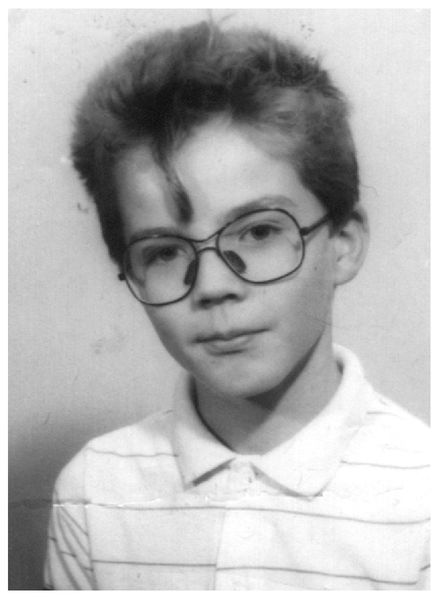
HENDRIK MÖBUS
WHAT HAPPENED AFTER THE MURDER?
Due to blind confidence on the part of Sebastian, he told a girlfriend we were in contact with about what happened. She told others about this event, and eventually the parents of our victim became aware of it. They scoured the forest, without knowing their son was buried there, and discovered his damaged shirt. They alarmed the cops once again, who questioned us, among other pupils, about where Sandro could be. A person who did know about our involvement in Sandro’s disappearance, and who disliked us, told the cops what he knew, and thus they arrested us the same day, one week after our deed. I was at home when they came—school was just over this day—and I tried to contact Sebastian and Andreas in order to create some kind of alibi. But the cops were quicker (and I did not know they were already informed, otherwise I would have tried to be even quicker myself!) and arrested me and, a few hours later, my two accomplices.
WHAT WERE YOU EACH FOUND GUILTY OF?
Due to our age of 17, they had to use the youth laws for punishment, which meant a maximum of ten years in detention, no matter if even for mass-murder. At the start of 1994 our trial took place, which was a giant media spectacle. Among other things, the court found us guilty of first degree murder, deprivation of liberty, threat and duress, and bodily injury.
WHAT WERE THE JAIL SENTENCES YOU RECEIVED?
Sebastian and myself were each sentenced to eight years of detention, and Andreas received six years. Now, taking into account the usual punishment for murder—life in prison—we got off relatively lightly. Lastly none of us had to serve the full sentences that we were given; we all were granted early release.
Ironically, the section we were sentenced under is one of the few pieces of legislation that remains today from National Socialist jurisprudence. Apparently something from the Third Reich held good for modern German “democracy”!
BEYER FUNERAL ANNOUNCEMENT
HOW DO YOU LOOK BACK ON THE MURDER NOW, SEVERAL YEARS LATER?
Basically all of us regret the terrible situation that we brought to our families. This familial liability was and is a fact that we can’t come to terms with. Although what happened with Sandro was not planned, it can absolutely be seen as the ultima ratio in the disagreement between him and us. On a societal level death and murder are so mundane, but individually they are extremely archaic and consciousness-altering experiences. Through a deed of this sort one breaks through borders and reaches regions that play no role in ordinary reality. In this sense it actually has to do with the human “twilight zone” and one becomes a stranger to this “normal” world. Nobody who has not experienced something similar can understand that. I also do not wish to ever explain it to anybody, and with this I should always justify it to myself. Indeed, regarding the deed itself there is nothing that can be changed. “Den Tod geben und den Tod empfangen” [“To give death and to welcome death”]—this was once the motto of the Waffen SS and says much about the original and Germanic relationship to such things. Someone was dealt death by my hand; sometime I may be in his place. Amor fati?
HOW DO YOU FEEL ABOUT HOW YOUR CASE HAS BEEN PRESENTED IN THE PRESS?

Our case was publicized throughout the entire German media, both TV and print, quite a lot from May ’93 to May ’94, and even in the following years. Besides the trashy book Satanskinder, at least three other books feature our case. However, this book is certainly wrong with its version (although several phrases sound familiar...), due to the fact we refused to cooperate. A TV-film has also been made based on the events in Sondershausen. We have become “Satan murderers” and “Children of Satan” for all time. One could laugh about these stories, which are eternally the same old thing, if only they hadn’t led to such dire consequences. Apart from the media’s self interest for an ongoing story, there are also circles of people that have utilized the media for engaging in personal conflicts with, for example, my parents. It has long since ceased to have anything to do with “discovering the truth” (if that ever had even played a role) or “informing the public.” It has to do with chicanery, with calculated slander. It can further be asserted in my case that I turn more and more into the archetype of the scapegoat. I am the modern Loki, whom the gods punished for their own sins. That sounds now like tragic self-aggrandizement and self-pity, yet the process of my demonization does actually go on. In the meantime you only hear about me in connection with the murder, as if I were the lone killer of Sandro. Besides, to me alone is attributed the leading role in all of the incidents, which perhaps have only the farthest thing to do with my crime. Through the constant propaganda against me such a poisoned climate has been created in public that barely anyone desires to be made aware of the truth, in others words, to pay attention to the factual relationships. The people say, “Some of it must be true,” for they cannot imagine that they have been duped with an incessant brainwashing propaganda from the side of the media. But I’ve also gotten the accusation that this constant reporting was something desired and encouraged by us. For my part, I would like to deny this. I could have meanwhile appeared on nearly every TV station and in every magazine and expressed my opinions, but I have nearly always refused those offers. It is unpleasant and even embarrassing to me when I read my name in the paper and see my picture. I don’t wish to be a “public figure.”
HOW HAS IT BEEN FOR ALL OF YOU SINCE YOU WERE RELEASED FROM JAIL?
Andreas was released a year before Sebastian and I. After getting reacquainted with the scene for a half-year (among other things, he attended a Mayhem reunion concert in Bischofswerda), he retreated completely back into his private life. He broke off all contacts, lives with his girlfriend, and has a good job. Even if I was unhappy about his “departure,” I nevertheless wish him all the best. Sebastian has totally devoted himself to a folkish world of ideas. He is married and has made a small circle of friends and acquaintances in which he actually plays the same role as he once did in our clique in Sondershausen. In the meantime he has also recorded and released new Absurd material. In addition he sings with Halgadom, a joint project with the band Stahlgewitter who are friends of his. He has only a peripheral contact with the scene, a situation that has probably kept him out of the media’s sights. It is different with me, for I have always had and maintained numerous contacts in the scene. In addition, I worked at Darker Than Black Records, through which I naturally was in a more prominent situation than my two former accomplices. Since then the media has decided to put me in the stocks and clothe me as their new scapegoat. Because I also nurtured an association with nationalistically inclined people, I have been charged severely. Nobody was interested in the facts anymore, the only thing that counted was sensationalism. This spectacle left me with no possibility of gaining a foothold in society again.
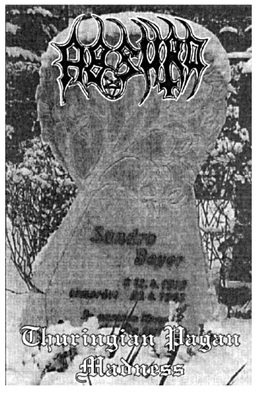
ABSURD CASSETTE COVER WITH BEYER TOMBSTONE
Since my release I have not hurt anyone or destroyed anything. But it has long since had anything more to do with what I did, but rather with what people think about me and do to me. Through the efforts of the leftist opinion cartel, my behavior—which in other countries would be of no consequence—was ultimately depicted as if I had committed the worst crimes against humanity. This process can no longer be halted; it goes beyond my destruction. It was my undoing that I had willingly guided not only my life but that of Andreas and Sebastian—I am a quasi-“missing link” between the two of them.
DO YOU FEEL BLACK METAL IS STILL AN IMPORTANT FORM OF MUSIC?
If you’re talking about the Black Metal underground, then I would agree it’s important, but if you’re talking about the fashionable music biz, then I have to point out that we don’t care about it. If “musicians” feel the urge to prostitute themselves to the business, then let them do so. They will perish, along with the Judeo-capitalistic system they are a part of.
Black Metal from its very core is very important and influential—especially now, at the dawn of the New Aeon, when Christendom will perish and a neo-heathen state will arise. “Herr Wolf ” once declared: “A violently active, dominating, intrepid, brutal youth—that is what I am after. Youth must be all those things. It must be insensitive to pain. There must be nothing weak and tender about it. I want to see once more in its eyes the gleam of pride and independence of the splendid beast of prey. I want my youth strong and handsome. They shall overcome mortal dread in the most difficult trials. That is the stage of heroic youth.” The youth influenced by Black Metal and other ideologically related music corresponds to “Herr Wolf’s” description almost wholly. A youth without false scruples, discarding altruism and morality, the youth of the New Aeon, the new Reich.
We really appreciate the sinister art of Black Metal, and will never change our style, because we became aware of Black Metal as the sound of the forthcoming Aeon of Horus, and the return of Wotan: still absurd, undreamt of by the narrow-minded, but nevertheless the soon-to-be reality, our reality, beyond all doubt! The sun is rising over Europe—will it destroy us or give us light?!
ABSURD ASGARDSREI
The harshness of the rhetoric behind Absurd has intensified immeasurably since their early days among the high school students of Sondershausen, as has their music. Beginning meagerly with hymns to demons discovered in Satanic horror films, the early demo cassettes of the band are low-fi chunks of adolescent noise, soaked with distortion and offering unintentionally humorous spoken introductions to the songs. Their music is more akin to ’60s garage Punk than some of the well-produced Black Metal of their contemporaries—but what they lacked by way of musical execution they were more than willing to make up for with the real-life execution of the sad figure of Sandro Beyer.
Lyrically they have always sung the praises of revenge against one’s enemies, and a number of their earlier songs appear to refer to—or portend, depending on when they were written—their killing, through a recurring leitmotif of murder in the forest. Pushing the limits of poor taste a step further, one of the Absurd cassettes released since their incarceration employed a photo of Sandro Beyer’s tombstone for its cover art.
If there is any clear spiritual mentor behind Absurd’s transformation over the years, it is Varg Vikernes. Varg himself seems to be aware of this, and smiles when talking of recent events inspired by what happened in Norway: “In Germany some churches have burned. And there are the Absurd guys, who have also turned neo-Nazi....”
14 Judging from the interviews conducted with Hendrik above, Varg’s remark about the ideological transformation of Absurd is correct. The long quotation Hendrik attributes to “Herr Wolf” at the end of the interview is in actuality the words of Adolph Hitler, speaking of the new prototype of hardened, pitiless youth which Nazi Germany would produce.
Similarly to how Varg once brazenly put a picture of the burnt remains of Fantoft Stave Church on the cover of Burzum’s
Aske mini-LP, Absurd’s
Facta Loquuntur disc also prominently features a photo of the charred framework of the Frogn church, which was torched in Norway in 1995. The title of the album is Latin for “deeds speak for themselves,” and the liner notes exhort the listener to “Remember your pagan origins and follow always the honorable way of your pagan ancestors!” A few sentences further they state, “This release is dedicated in everlasting worship to our martyrs who died or have to suffer in one way or another in order to set a flaming sign for our movement. Our kingdom will come.”
15 Such sentiments would make Varg Vikernes proud. Absurd’s own tiny record label, Burznazg, takes its name from a term Varg once planned to use for his own operations, and the most infamous criminal in Norway was surely proud to know of the “Tribute to Burzum” compilation CD project initiated by Hendrik Möbus and friends.

GERMAN HEADLINE: “CHAPEL WAS IN FLAMES”
The band still continues despite their jail sentences, although they have encountered numerous obstacles. Originally incarcerated together in the Erfurt prison, after a period of time the media made a scandal of the fact that the three killers had regular contact with one another inside the prison walls and were being treated much too nicely in light of their crime. Hendrik explains:
In March of ’95 the self-declared “Grand Inquisitor,” an evangelical parson named Jürgen Hauskeller, together with a member of German parliament, Vera Wollenberger, visited the jail in Erfurt. Although the warden of the jail refused to let them inside, Wollenberger enforced the right for this visit with the help of the Thuringian ministry of justice, and thus they came to look at what was going on with us. Certainly they expected to see us suffering with only bread and water, and were badly surprised to find the opposite was true—we lived together on the same floor, made music together, and so forth. After this visit, they managed to start a hostile campaign against us via the yellow press, by telling how “good” we had it behind bars. The mother of our victim then declared her son had died all over again, and she demanded they stop our alleged “holiday” and start the punishment. The consequences were that each of us has been moved to a different jail, and the warden at Erfurt lost his job, due to the alleged “privileges” he gave us.
16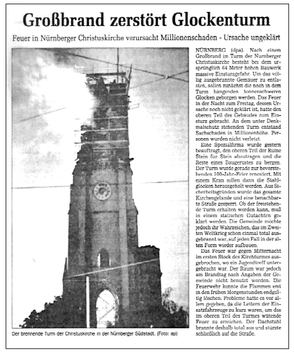
GERMAN HEADLINE:
“ENORMOUS BLAZE DESTROYS BELFRY”
The trademark Black Metal pseudonyms of Absurd’s personnel have changed since their first recordings, and by ’94 they had adopted titles from dark aspects of Germanic mythology, recasting themselves as “Surt,” the fire giant who ignites the earth at Ragnarök; Nidhögg (literally “the one striking full of hatred” in Old Norse), the dragon who gnaws at the roots of the world-tree and drinks the blood of corpses; while Sebastian, formerly known as “Werwolf Dark Mark Doom,” has now shortened his appellation to simply “Doom.”
Like Vikernes, Hendrik is of considerable intelligence, and has spent his time behind bars delving deep into the legends and romanticism not only of heathen Germany, but the history and esoterica of the Third Reich as well. While the status of Absurd is certainly limited to the far reaches of the underground, their records have continued to appear and find an audience. The band demonstrated they could engage in the acts they sang about, thereby endowing themselves with a unique aura of “authenticity.” The fact they were willing to spend nearly a decade in jail for the experience of committing murder gives them a perverse form of credibility over the bands who merely sing and dream of empty morbid fantasies. By their actions they also set a grim example—as Bård Eithun and Varg Vikernes did before them—which others may feel compelled to live up to.
Möbus also reveals the existence of a Germanic “Black Circle” which he claims the members of Absurd are also connected to, called
Die Teutsche Brüderschaft (Teutonic Brotherhood). The
Brüderschaft is mentioned prominently in the dedication list on Absurd’s debut CD. Still, Hendrik wonders, “Considering the effects Black Metal is causing, I’d expect something to spread like a wild fire across Europe. It’s difficult to say why this has yet failed to appear.”
17 It may be that the contemporary German environment is somehow lacking the ingredients that allowed Black Metal to take the extreme turn it did in Norway, but there is evidence that the potential exists.
As an aside during an interview we conducted with Dani, the driving force behind British gothic Black Metal band Cradle of Filth, he mentioned a fleeting encounter they had during one of their early tours with a knife-wielding German youth who claimed to be part of a “Satanic Gestapo.” Whether this is the same as the “Teutonic Brotherhood” spoken of by Hendrik is unknown.
DANI—SINGER OF ENGLISH BAND CRADLE OF FILTH
HAVE YOU HAD ANY PROBLEMS WHILE ON TOUR?
We have abroad. Some German guy from the “Satanic Gestapo,” I think they were called, who jumped on stage with a carving knife. This was on the Anathema/At the Gates/Cradle of Filth tour, and I was looking the other way when the bouncers grabbed him, and basically beat the crap out of him and threw him on the floor. But he came up afterwards and apologized, and just said, “Oh, sorry,” really innocently. I think he just said the knife was a prop, but we were getting threats from people all over Germany. There was a band called Pyogenesis, and these kids who were the mouthpiece of the lower rank of this supposed “Gestapo” were telling people that the girlfriend of a guy in Pyogenesis had been stolen from him and abducted, and they’d been repeatedly raping her.
CRADLE OF FILTH
THEY ACTUALLY DID THIS?
No, they didn’t do it at all. It was bullshit. We saw the guy in Pyogenesis and he said it was absolute rubbish. But we’d heard it from people at a concert saying, “Beware, they mean it,” and it was frightening if you put it in context, that people would make threats like that.
In other communications, Hendrik reported that in Germany a number of churches and chapels have burned, or were attempted to be torched, under suspicious circumstances. He elaborates:
From late ’93 until early ’97 there have been around around a dozen church arsons (including attempted ones and/or desecrations inside the church) throughout Germany. Almost all of them have a proven link to Satanism or Black Metal, due to unequivocal symbolism at the scene of the crime. Most of the important events (countless small and large cemetery desecrations, a couple of damaged or burned churches and chapels) took place in Thuringia and Saxony. Some examples: a church desecration in the town of Greiz during the spring of ’94, a series of cemetery desecrations along with a burned chapel around Leipzig during ’95–’96 (those “criminals” have been caught already), and a church burned to the ground in Riethnordhausen during the spring of ’97. The most recent church fires happened in Lübeck, Hamburg, and Husum (all in north Gemany) during four weeks in April and May ’97, but the police, who once again caught all the “criminals,” said almost nothing about their background except for that of a link to the right-wing scene.
18
Churches have also been set alight in nearby Poland—or “Eastern Germany” as Hendrik terms it, recalling Hitler’s “Großdeutsches Reich.” About the church attacks he elaborates, “Many more were damaged and profaned, and even countless cemeteries desecrated likewise—but all this I can sum up as ‘after-pains’ of the Norwegian events.”
19 Overall in Europe as of 2002, Hendrik claims to now be aware of more than 100 acts of anti-Christian arson, although it impossible to know on what he bases this figure—presumably rumors circulating in the underground he is a part of.
The atavistic element of Black Metal can be seen in the evolving efforts of Absurd, who are beginning to employ more recent and incendiary paradigms from the tumultuous Germanic legacy in their worldview. How many others may be awakened to follow in their halting footsteps? In their song “The Gates of Heaven,” written some months before they dispatched Sandro Beyer from earthly existence, Absurd demand in slightly broken English:
“Straight on through the gates of heaven, Evil will destroy the souls—Where’s your saviour, where hides Jesus? Why isn’t he at war against us?”20 Unhindered even by temporary confinement to prison, their question is a mocking one.
“HEATHEN HORROR”
It is difficult to document how many of the church arsons and attacks in Germany that occurred in the late 1990s actually emanated from the Black Metal scene, but there is no doubt that in many instances a connection exists. As evidence of one minor such incident we can quote from an anonymous communication that was received by the authors in the Autumn of 2000. A two-page letter accompanied by two blurry photos, the missive was entitled “Heathen Horror” and related various accounts of church desecration before signing off with the exhortation “Kill for Wotan!” We are unable to verify any details of this account (including whether or not the “Surt” mentioned here is also the member of Absurd who uses this stage name), but the photographs, despite their poor quality, would lend a degree of veracity to the story. We offer a section of it here in translation to provide a glimpse into the moonlight activities—in all their earnest incompetence—of a militant segment of the German Black Metal scene.
On a cold November night in 1999 “Surt” and “Tyrann” traveled through towns in the countryside in order to find a remote church that could be set on fire. After some hours of searching we found a secluded House of God in a small village, situated far enough from the town that we would not be heard. We had prepared for our project with torches, kerosene, a crowbar, and a sledgehammer. We parked the car about a half-kilometer away, so that possibly no one might connect it to the action. Were someone to in fact notice us at the church and call the police, we would hear it immediately over a police scanner, and still have time enough to disappear undetected since the closest police station was in the next town many kilometers away. Besides, nothing usually goes on in little towns. After a long trek we reached our goal. We made it over a low fence to the cemetery where the church was also located. It was quite a sight—the church lit by moonlight and the red glow of the graveside candle lamps. After trying unsuccessfully to get the main door open with the crowbar, we crept around the church to find another way in. At the vestry, we finally managed it. We were very nervous and just wanted to hurry. Without looking around us much, we stormed into the main part of the church—by the light of our torches—to lay waste to it and spread the flames. Surt took the kerosene out of his backpack and poured it over the pews as Tyrann held his torch to it and… nothing happened! Shit! It can’t be true! All that energy for nothing? We tried to get the fire going with the kerosene; this looked especially good by night inside the church. Again we poured kerosene on the pews, now more than before. Again Tyrann held his torch to the wet pews, and again nothing happened! In a hurry and mad rush we lay candles, seat pillows and whatever else we could find on the pews and lit it. Smashing the window panes, we took off at that moment since we were too nervous and just wanted to get out as quickly as we could. So, okay—the church wasn’t burnt down. But it was still a decent desecration, since all the church pews were ruined with fire damage, so that no church services would be taking place there anytime soon.

RADICAL RIGHT-WING ASYLUM SEEKERS?
After serving the court-ordained portion of their jail sentences, the youths convicted in the slaying of Sandro Beyer were all released on parole. As Hendrik mentions in the previous interview, only he and Sebastian carried forth with the musical endeavors of Absurd. The band’s reconfigured record label, now called Darker Than Black, also began to develop a higher profile. Hendrik renewed his contacts in the music scene and appeared in a few Black Metal fanzines. In July of 1999 announcements circulated about the release of Absurd’s new 4-song CD entitled
Asgardsrei. The CD featured a more aesthetic presentation and an evolved sound, although with much of Absurd’s garage-band ambience still intact. Guests on the release included Graveland’s Rob Darken and well as an “ex-member of the German mainstream band Weissglut.” The end of the advertisement advised interested customers to “ORDER IT NOW before ZOG
21 take YOUR copy.”
This warning about the confiscation of CDs by governmental authorities was not overly paranoid, however, as just a few months later on October 6, 1999, the German police raided a number of homes across the country, in particular the residences of the Darker Than Black and No Colours record labels. The initial charges consisted of “distribution of National Socialistic, anti-Semitic, racist, and violent releases.” Hendrik commented at the time, “This is the first time that the Black Metal scene has experienced the same kind of charges as the White Power scene.” He later noted that the government’s actions failed to result in any legal proceedings against those who were subject to the raids, meaning that the items found in the raids—with Absurd records prominent among them—were not sufficiently in violation of the law to make for a strong court case.
But the governmental crackdown on the record labels was the least of Hendrik’s problems. The public prosecutor had now decided to launch an effort to revoke Hendrik’s parole on the basis of alleged political crimes he had committed since his release from juvenile prison. These consisted of displaying banned political emblems and also giving a “Hitler salute” at a concert.
In September of 1999 the court ruled against Hendrik, and he immediately tried to appeal the decision. Attempting to remain stoic in the face of these new developments and the resulting media furor, he commented: “Narrow-minded people even claim that I want to be the German counterpart of Varg Vikernes, but honestly speaking, I have never wanted to experience the ‘Vikernes-effect’ on myself at all. However, there is no point lamenting about my fate. I have to accept this burden and must try to make the best out of it.”
It was around this time that Hendrik disappeared from public view, leaving the musical demimonde behind, and went truly underground. Rumors have abounded concerning the details of his subsequent actions, but it is certain that he managed to eventually fly to America and arrived in Seattle, Washington toward the end of 1999. Travelling across the U.S.A., Hendrik passed through a string of ill-fated liaisons with racists upon whom he depended for safehousing, culminating with two of them violently threatening him. Following this incident, he eventually made his way to the state of West Virginia and to the headquarters of William Pierce’s racialist group the National Alliance. All was relatively quiet for a number of weeks until Hendrik was arrested in late August, 2000 by U.S. federal agents acting on an international warrant. The German government had requested to have Hendrik extradited to face his charges of parole violation.
The press treatment of the case was unusual, with Hendrik being elevated from a “Satanic murderer” to a “neo-Nazi fugitive.” He became an international cause célèbre—garnering headlines in U.S. News and World Report, as well as major papers like the Los Angeles Times and the Washington Post—and his case raised many serious issues about the way in which modern democratic states handle persons who they deem as threats to democracy itself. Soon after his arrest, Hendrik wrote a letter to U.S. President William Clinton and Attorney General Janet Reno and requested status as a political refugee, stating that if he were extradited back to Germany he would be persecuted on account of his political beliefs.
Hendrik was supported in his legal defense by the National Alliance, with William Pierce soliciting donations to help offset the cost of lawyers. A “Free Hendrik Möbus” campaign was also launched on the Internet, and William Pierce produced episodes of his radio program American Dissident Voices in which he addressed the topic of Möbus’s case in detail. In the first major ruling, the U.S. magistrate decided that Hendrik was not eligible for political asylum as he was a “convicted felon” in Germany. Hendrik then attempted to appeal the decision. In their commentaries on the case, both he and William Pierce attempted to make the fundamental issue one of free speech, since the actions which resulted in the original parole revocation were not of a violent nature, but rather “political” misdeeds (which would be perfectly legal according to U.S. laws). Both the U.S. and German governments tried to avoid this thorny issue and confine the legal proceedings to the logistical issues of Hendrik’s parole violation itself, rather than debating the validity of the charges that led to the violation.
Hendrik’s support website <
www.hendrikmoebus.com> raises similar issues. Alongside a wealth of newspaper articles about the case, the site contains a number of essays and articles, written by Möbus himself, which question the Federal Republic of Germany’s behavior toward political dissidents. In one article, an “Open Letter to the German Nationalists,” Hendrik explains why he hopes they will stand on his side:
The louder and more publicly this and other questions are discussed in Federal Republic of Germany and in the USA, the more the authorities will claim that a state of emergency exists. They will try to hush up my case and try to distort and cover up the facts.
You, however, can help prevent this. I urgently request that you do not let this opportunity pass by. If the national resistance in Germany does not use my case for its purposes, the system will abuse my case to damage all German Nationalists.
MÖBUS MAKES U.S. HEADLINES
I do not make this request so that I can be the center of attention. I do not want to play a role in your organizations. But I know how serious and dramatic our situation in Germany is. This situation requires unusual and detailed commitment. My case provides an opportunity for this. Who knows, perhaps a US court will grant me asylum. This would be an impressive demonstration of what we have known for a long time: the Federal Republic of Germany is not a democracy, but rather a criminal state!
When Hendrik Möbus arrived at William Pierce’s compound, Pierce was in the process of building up his Resistance Records music label and hoping to expand its horizons outside the skinhead genre. Hendrik was eager to get involved, for he had already tried to bridge the gap between skinheads and Black Metal youths in Germany. In an effort to make Black Metal more palatable to the other radical elements of the racial movement, Hendrik has also written about the genre for Pierce’s magazine (under the pseudonym “Hagen von Tronje,” a reference to the dark figure of the medieval German epic The Nibelungenlied). One of the main obstacles toward Black Metal’s acceptance in the arena of radical politics stems from its Satanic and frenziedly destructive past. Along with Varg Vikernes, Hendrik Möbus is therefore endeavoring to present the musical movement he is connected with in a wholly militant heathen light, now devoid of the old Satanic imagery. This may ultimately be a futile cause, for Black Metal has been defined by its Satanic tendency from the earliest beginning, and old perceptions die hard.
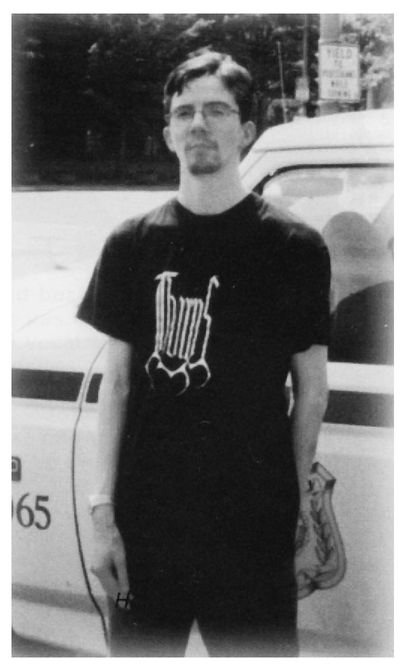
HENDRIK MÖBUS SHORTLY BEFORE HIS ARREST IN WEST VIRGINIA
In stark contrast to his stated desire “not to be a public figure,” Hendrik Möbus inadvertently became a subject for international news headlines. His strategy for avoiding extradition created a further paradox: he was forced to seek the mercy of liberal democratic political asylum laws—exactly the sort of laws which a strident German nationalist would vehemently oppose in their own country for anti-immigration reasons. Ultimately his ploy was unsuccessful, and on July 29, 2001 Hendrik was extradited back to his Vaterland and into the custory of the Thuringian Justice Department, who decreed that he serve the three-year remainder of his original sentence. Two further court judgments against him, one for public display of the Hitler salute and the other for mocking his victim in published statements, have added more than two years of additional incarceration to the time he will serve in jail. It quickly became clear that Hendrik’s personal goal of collaborating with William Pierce in a venture to promote radical Black Metal through the racial music underground would be impossible to realize from a German prison cell. An equally significant obstacle arose exactly one year later when William Pierce died suddenly from cancer on July 23, 2002. Whether the organization and record label he leaves behind will still endeavor to capitalize on the Black Metal market remains to be seen.
